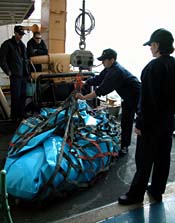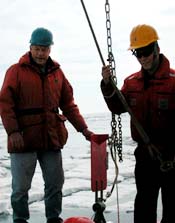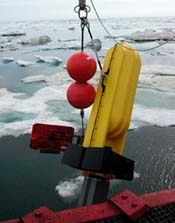|
|
 |
 |
 |
|
While most of the ship’s crew enjoyed a day of rest today, the Marine Science Division finished repairing and testing the CTD. Here they are performing a “load test” - picking up a bag of water to see if the newly repaired connection would hold. |
|
Click to enlarge |
 |
|
David Leech (left) and Tom Molloy (right) attach another instrument to the mooring line. |
|
Click to enlarge |
 |
|
The final float (yellow) is aerodynamically shaped to reduce drag. Standard spherical floats can tilt sideways in the strong Barrow Canyon currents. |
|
Click to enlarge |
Daily Update
Calendar
Dispatch 20 - August 3, 2002
By C.A. Linder
Weather conditions: clear skies, calm winds and seas, air temperature 47° F.
Bluenoses
Last night I received a summons. On the morrow, I was to appear before The Royal High Court of the Polar Bear to answer to the charges brought against me! I was accused (among other things) of “Excessive consumption of water (showers) on the Polar Star and dilution of my precious Arctic Ocean!”
However, I wasn’t alone. Bob Pickart, Sarah Zimmermann, Dan Torres, and Aaron Morello had also never crossed the Arctic Circle before, and were thus lowly Bluenoses too. Without mentioning any names, some of the charges included:
“Repeated violations of cyber privacy in the High Arctic.”
“Did willfully and knowingly consume excessive amounts of sugar on watch and attempt to use the lab as a climbing gym.”
and, my personal favorite:
“Calling yourself an Arctic scientist just because you have a shiny new float coat.”
Davey Jones and I. Polar Boreas have unfortunately forbidden me from describing this morning’s proceedings, but I will say that it involved being COLD. It was a lot of fun, too. This was the first time I have crossed one of the imaginary lines on the globe that has a “crossing ceremony.” The others are the Antarctic Circle (Penguin), the Equator (Shellback), and the International Dateline (Golden Dragon). After our Bluenose ceremony, the Captain granted the crew a day off from normal work duties. For some, though, there was work to be done...
Shortly after lunch, David Leech led the deployment of the UW/UAF Barrow Canyon mooring. We had attempted to put in this mooring on July 24th (see Dispatch 10 for details), but the ice was too thick. Luckily, today the ice was much more cooperative. Since the deck crew had already deployed eleven moorings, this operation was a breeze. Both David Leech and John Kemp were extremely happy about that, since later that day they were catching flights out from Barrow, Alaska’s airport! Mere hours after the mooring went down to the bottom, David and John were suited up and headed out to the helicopter. A short 20 minutes later, they were on the ground at the Barrow airport. The science crew now numbers seven: Tom Weingartner, Bob Pickart, Dan Torres, Jim Schmitt, Aaron Morello, Sarah Zimmermann and myself.
Now that all twelve of our moorings have been successfully deployed, it’s back to the CTDs. Earlier today the Polar Star’s Marine Science Technicians finished repairing the CTD termination and it’s working beautifully. Now we’re making the most of our remaining days to do as many CTD casts as possible. We will be studying the waters of Barrow Canyon and then moving on to a section across the Chukchi shelfbreak.
Here is a question I have received via the arcticedge@whoi.edu email address:
Q: Dear Chris, What is the ship made of and how thick is it in the ice breaking regions? Thanks, Tyler
A: Tyler, the hull of the Polar Star is a thick 1.75 inches of solid steel in the bow and stern sections, and 1.25 inches thick amidships. In addition, a complex internal support structure makes the hull even stronger, strong enough to pound through ice up to six feet thick. Thanks for writing!
 Previous Dispatch
Next Dispatch Previous Dispatch
Next Dispatch

Back to Calendar
|
|




